 |
 |
 |
| |
In Big US HIV Group, Hispanics, Blacks, Southerners, Overweight Run Higher COVID Risk
|
| |
| |
IDWeek 2022, October 19-23, 2022, Washington, DC
Mark Mascolini
In a database of 43,173 HIV-positive people in the US, being Hispanic or black, living in the South, or being obese predicted higher odds of COVID [1]. Further analysis tied being underweight to higher odds of severe COVID outcomes. Smoking did not emerge as an independent risk factor for getting COVID, but it did boost odds of severe outcomes. More comorbidities upped odds of COVID and more severe COVID in this big HIV group. - low CD4 associated with increased risk of developing COVID; detectable HIV viral load associated with increased risk of hospitalization - but not low CD4; for risk of ICU & death all HIV variables including detectable HIV viral load, low CD4 & not being on ART were associated.
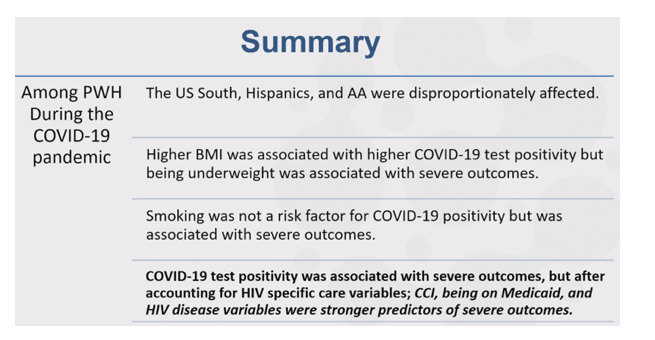
Previous research including people with or without HIV infection identified several signals of severe outcomes: older age, comorbidities, male gender, high body mass index, black race, and injection drug use. This new study by researchers at the University of Texas Southwestern Medical Center included only people with HIV and aimed to isolate risk factors for COVID and severe COVID outcomes.
The investigators tapped the OPTUM COVID-19 national multicenter database to identify 43,173 people with HIV based on ICD codes, antiretroviral therapy (ART) use, or lab results. Using PCR or antigen tests, they determined that 6472 people (15%) had SARS-CoV-2 infection and 36,701 did not. People 18 to 49 years old made up 55.5% of the SARS-CoV-9-positive group versus 51.5% of the negative group. Proportions of positive and negative 50- to 64-year-olds were 31.3%versus 33.7% and of people 65 or older 13.2% versus 14.8%.
Women represented 37.0% of those positive for SARS-CoV-2 and 34.6% of those without COVID. Men made up 63.0% of people with COVID and 65.4% of those without. Hispanic whites accounted for 8.5% of people with COVID and 2.8% of those without. Non-Hispanic whites made up 43.8% of those with COVID and 49.9% of those without. Blacks represented 27.5% of people with COVID and 26.2% of those without.
Among people positive for SARS-CoV-2, 21.1% currently smoked and 78.9% did not. Among people with COVID, 53.8% had commercial insurance, 17.6% had Medicaid, 13.0% had Medicare, 7.6% had another type of insurance, and 7.9% had no insurance. In the SARS-CoV-2-positive group, 2.3% were underweight, 31.9% normal weight, and 29.9% overweight; 20.4% were in obesity class 1 (BMI 30 to <35 kg/m2), 10.4% in obesity class 2 (BMI 35 to <40 kg/m2), and 9.4% in obesity class 3 (BMI 40 kg/m2 or higher). Charlson comorbidity index averaged 1.96 in people positive for SARS-CoV-2 and 2.06 for those negative for the coronavirus.
Logistic regression analysis adjusted for age, gender, race, ethnicity, US region, insurance type, Charlson comorbidity index, body mass index, and smoking status identified several independent predictors of COVID in SARS-CoV-2-positive people with HIV at the following odds ratios (OR) and 95% confidence intervals (CI):
- Higher Charlson comorbidity index: OR 1.148, 95% CI 1.067 to 1.236
- Obesity class 1 vs normal weight: OR 1.203, 95% CI 1.111 to 1.303
- Obesity class 2 vs normal weight: OR 1.306, 95% CI 1.18 to 1.444
- Obesity class 3 vs normal weight: OR 1.351, 95% CI 1.213 to 1.504
- Uninsured vs commercial insurance: OR 1.575, 95% CI 1.406 to 1.764
- US South vs Northeast: OR 2.721, 95% CI 2.52 to 2.939
- Black vs non-Hispanic white: OR 1.164, 95% CI 1.089 to 1.245
- Hispanic white vs non-Hispanic white: OR 2.577, 95% CI 2.292 to 2.807
- Not currently smoking vs current smoking: OR 1.432, 95% CI 1.34 to 1.53
When the researchers added CD4 count, viral load, and ART variables to this analysis, only low versus high CD4 count emerged as an additional predictor of COVID-19: OR 1.276, 95% CI 1.04 to 1.566. (When using absolute CD4 count, the researchers defined low as below 200, medium as 200 to 499, and high as 500 or higher.) But adding HIV variables to the analysis eliminated some previously significant factors: Charlson comorbidity index, class 1 obesity, and class 2 obesity,
People with HIV admitted to the hospital within 30 days of SARS-CoV-2 testing had a long list of independent risk factors for hospital admission:
- Medicaid vs commercial insurance: OR 1.824, 95% CI 1.712 to 1.943
- Medicare vs commercial insurance: OR 1.401, 95% CI 1.299 to 1.511
- Uninsured vs commercial insurance: OR 1.182, 95% CI 1.041 to 1.342
- Not current smoker vs current smoker: OR 0.786, 95% CI 0.744 to 0.831 (lower risk for nonsmokers)
- Hispanic white vs non-Hispanic white: OR 1.216, 95% CI 1.065 to 1.387
- Black vs non-Hispanic white: OR 1.346, 95% CI 1.269 to 1.427
- Female vs male: OR 1.123, 95% CI 1.065 to 1.185
- Higher Charlson comorbidity index: OR 1.482, 95% CI 1.446 to 1.518
- Underweight vs normal weight: OR 1.659, 95% CI 1.449 to 1.898
- COVID-19 positive vs negative: OR 1.125, 95% CI 1.049 to 1.207
- Age 50-64 vs 18-49: OR 1.129, 95% CI 1.064 to 1.197
- US South vs Northeast: OR 1.393, 95% CI 1.286 to 1.507
When the researchers also considered the impact of HIV variables on hospital admission within 30 days of SARS-CoV-2 testing, only detectable versus undetectable viral load emerged as an additional predictor of hospital admission: OR 1.833, 95% CI 1.522 to 2.208. Adding HIV variables to the model removed all previously significant variables except Charlson comorbidity index, black vs non-Hispanic white, Medicaid, Medicare, and underweight.
Several variables raised odds of intensive care unit (ICU) admission within 30 days of a SARS-CoV-2 test in these people with HIV: Medicaid, Medicare, or uninsured versus commercial insurance, black race, male gender, higher Charlson comorbidity index, underweight versus normal weight, and living in the South or West versus the Northeast. When the investigators also considered HIV variables in this analysis, detectable versus undetectable viral load, low versus high CD4 count, and not taking versus taking ART all boosted odds of ICU admission. Adding these HIV variables to the model removed all previously significant variables except higher Charlson comorbidity index and Medicaid versus commercial insurance.
Many variables independently predicted death within 30 days of a SARS-CoV-2 test in people with HIV: Medicaid, Medicare, or uninsured versus commercial insurance, underweight versus normal weight, higher Charlson comorbidity index, COVID-19 diagnosis, age 50-64 versus 18-49, age 65 or older versus 18-49, and living in the South or Midwest versus the Northeast. When added to this analysis, all four HIV variables considered upped the odds of death: detectable versus undetectable viral load, low versus high CD4 count, medium versus high CD4 count, and not taking versus taking ART. But with HIV variables added to the analysis, four previous death predictors lost significance: COVID-19, uninsured versus commercial insurance, and living in the US South or West.
The University of Texas researchers proposed that there main finding is the link between COVID test positivity and severe outcomes-but after the analysis accounts for HIV variables, Charlson comorbidity index, using Medicaid versus commercial insurance, and the HIV variables become stronger predictors of severe COVID outcomes.
Reference
1. Hanna JJ, Geresu LB, Diaz M, et al. Risk factors for COVID-19 and severe outcomes among people living with HIV: a retrospective cohort study. IDWeek 2022, October 19-23, 2022, Washington, DC. Abstract 2357.
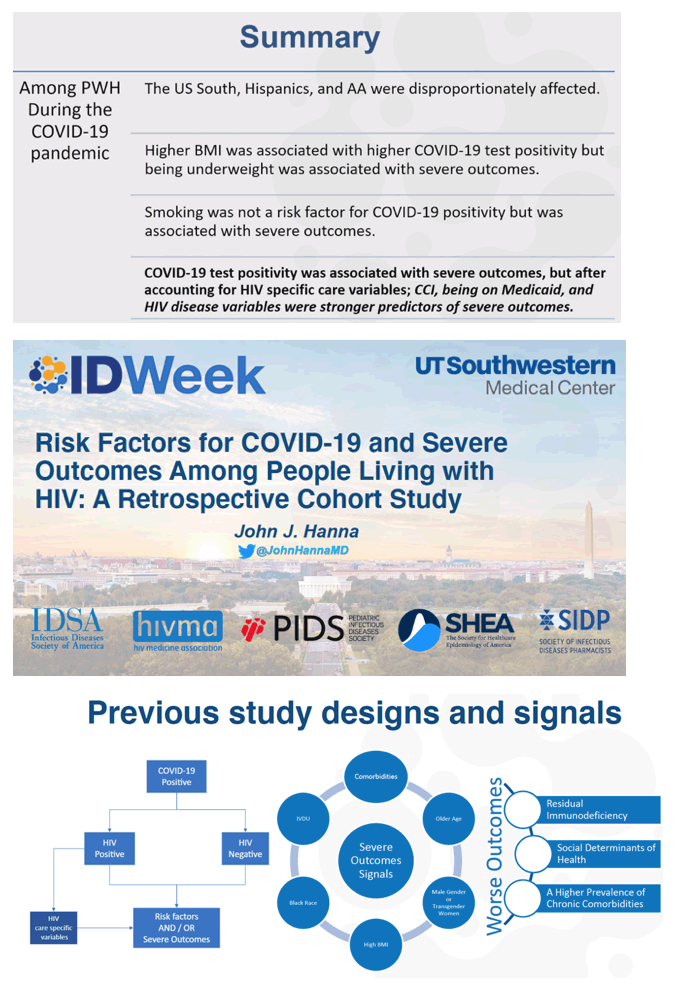
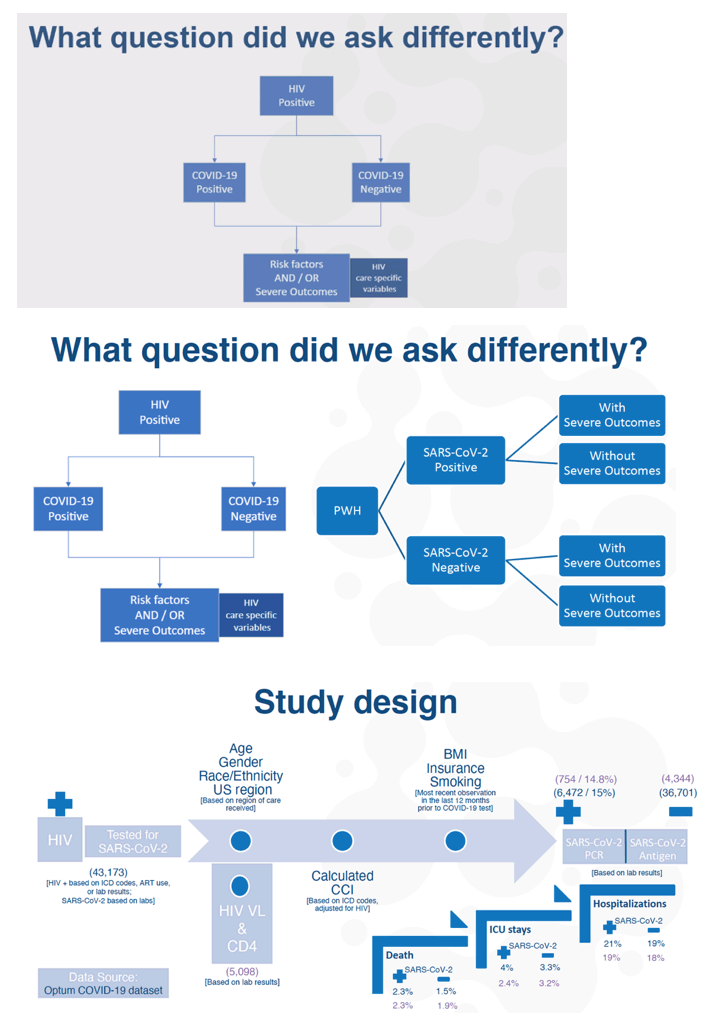
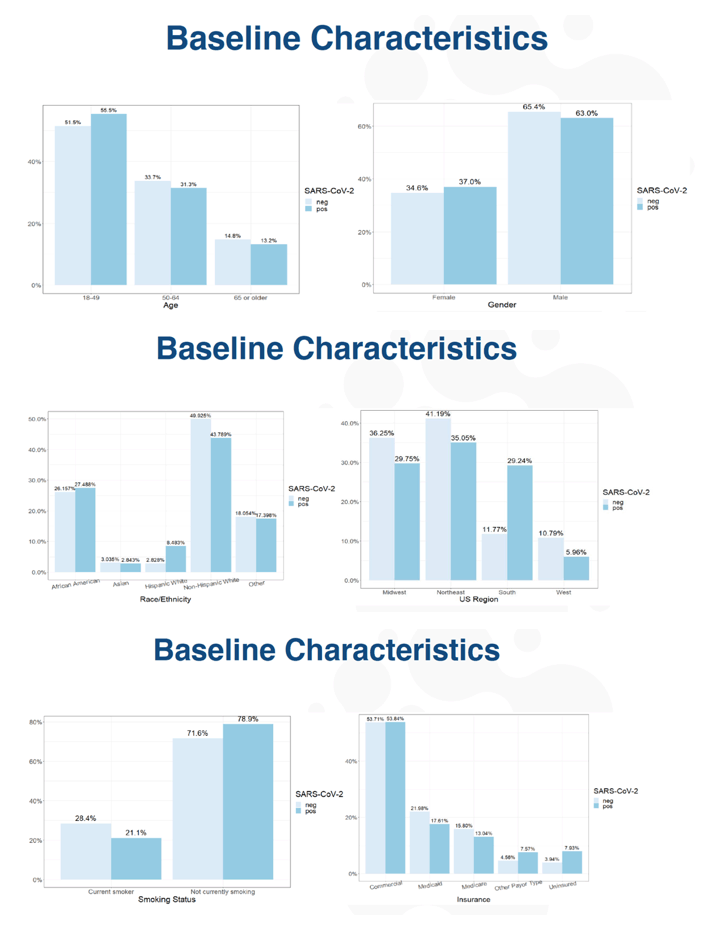
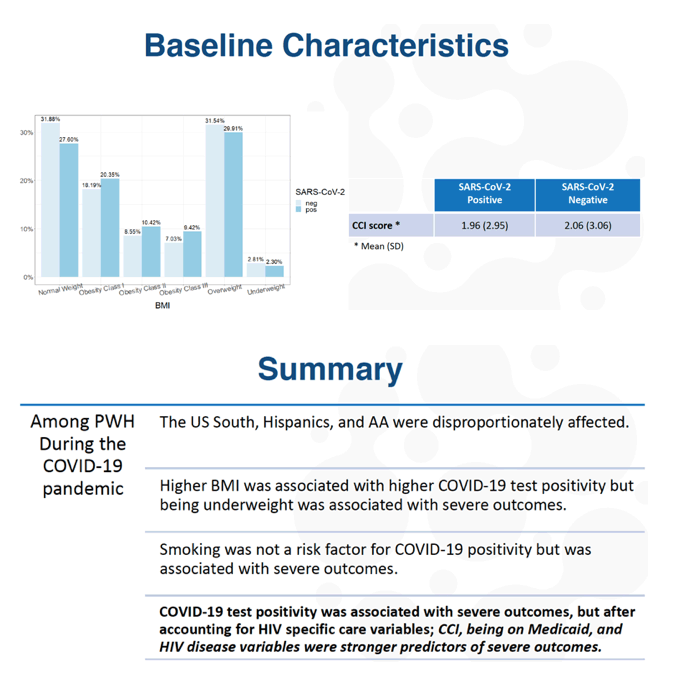
|
| |
|
 |
 |
|
|